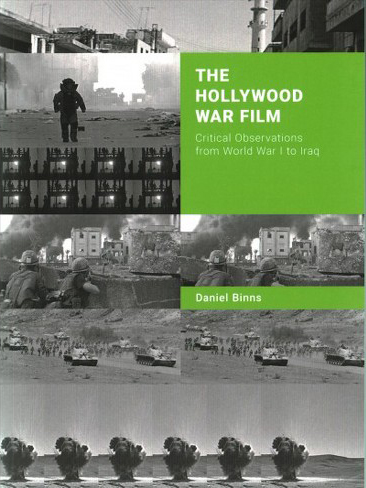Binns, Daniel - The Hollywood War Film : Critical Observations from World War I to Iraq, Bristol: Intellect Books, 2017 (pp. 172). ISBN 978-1-78320-754-1
Reviewed by Iqbal Barkat - Macquarie University
Genre analysis, as Robert Stam warned, is always in danger of narrowness, normativism, monolithic definitions and biologism. Daniel Binns’ The Hollywood War Film has avoided such pitfalls by offering a reading of the genre that captures its shifting nature across time and forms, starting with the grand narratives of Hollywood to more recent video games.
The book uses a wide range of scholarship from ‘genre theory’ to ‘transmedia storytelling’ to offer close readings of films such as ‘All Quiet on the Western Front’ (1930), ‘Apocalypse Now’ (1979) and ‘The Hurt Locker’ (2009), the comic series ‘Captain America’ and the video game, ‘Spec Ops: The Line’ (2012). The book contends that the war film genre mutates by identifying slippages, hybridisations and extension but that it is also inherently tenacious. One aspect that remains across the genre is the idea of war as necessary.
In a fractured environment where conflict proliferates, it would be easy to collapse a critique of war with any attempt to represent it. The book manoeuvres through polemics by underpinning its analysis on Russian Formalism, whose strength lay chiefly in focusing on the art object in, and of, itself. For Victor Shklovsky, one of the movement’s founders:
… [an] image is not a permanent referent for those mutable complexities of life which are revealed through it; its purpose is not to make us perceive meaning, but to create a special perception of the object – it creates a ‘vision’ of the object instead of serving as a means for knowing it (1981, p. 60).
The relation between an art object and the world is thus complicated beyond mere representation. A film does not simply reflect contemporary reality – it ‘facilitates a new way of perceiving [it]’ (1981, p.16).
Another advantage that (the recourse to) Russian Formalism affords, is its ability to enable analysis across forms. The book is thus able to examine comics and video games not because they are filmic, but in their own right. Chapter 4, the most interesting chapter in the book, examines these forms to show the pervasive workings of genre where transmedia elements are impacted by ‘narrative management’ (12). But it also suggests how such elements, including interactivity, are transforming the genre itself. This is an area that deserves deeper investigation.
One of the ways that art changes perception is through what the Formalists called ostranenie or defamiliarization. This is the key Formalist concept that the book adopts and uses to good effect to propose that the use of defamiliarising techniques in films ‘disrupt[s] the automation of reception’ (16) changing genres and adding to the corpus of generic attributes. Chapter 2 offers an excellent discussion of ‘All Quiet on the Western Front’ and its ‘alternation between harrowing combat and quiet reflection; its juxtaposition of the fleeting joys of life and the endlessness and pointlessness of death’ (33), techniques which were defamiliarising at the time they were deployed but which have now become tropes of the war film. The claustrophobic, seven-minute bunker sequence with its unrelenting focus on the mental trauma of the soldiers is now also a marker of the genre.
Quotes from the French thinker Paul Virilio are peppered throughout the book. This is rather unsurprising as Virilio’s entire thinking is framed by war and also partly, by cinema. For Virilio, technologies of representation are military technologies and they work to displace human perception. The book makes links between Virilio’s thought and Russian Formalism especially in its discussion of films made around and after the 1991 Gulf War, including ‘The Hurt Locker’. It is not difficult to draw parallels between the disjointed syntax of such films and military technologies, including body cameras, drones and night vision.
However, cinema is not just a war machine. The book makes the important point that while such films are technologically adventurous in cinematography and editing, they are also marking a return to a:
… thematic undercurrent borrowed from the great American war myth – the grand narrative – of the early twentieth century. It is a cinematic aesthetic informed by digital technologies, media coverage, and modern weaponry. There are significant changes to the way the story is told, but very few to the story itself (90).
The conciliation that films make between generic tropes and conventions and the deployment of new and defamiliarising techniques, is a theme that runs through the book. This demonstrates the influence of new media theory where old media is constantly remediated by new media but perhaps more significantly as the author is a film-maker, from practical film production where in the ‘“process of making sense” … a film-maker cannot simply re-write the rulebook, particularly with genres as established as the war film or political thriller’ (111).
The Hollywood War Film is a significant contribution to the study of cinematic genres and will appeal to both specialists in the field of film studies and students.
Reference
Shklovsky, V. (2007). Energy of delusion: A book on plot, trans. Shushan Avagyan(Normal, IL: Dalkey Archive Press, 1981), 296.
About the reviewer
Dr Iqbal Barkat is a filmmaker and Lecturer in Screen Production at Macquarie University, in Sydney, Australia. His films include ‘Mortars’ (2014), ‘Why Do You Want To See My Face?’ (2011), and ‘Dusk’ (2006). His PhD examined novelty in cinema. His research interests include independent cinema and community filmmaking. Iqbal co-authored (with Hart Cohen and Juan Francisco Salazar) Screen Media Arts (2009) which won the Australian Educational Publishing Award Tertiary (Wholly Australian) Teaching and Learning category 2009.
Email: iqbal.barkat@mq.edu.au

